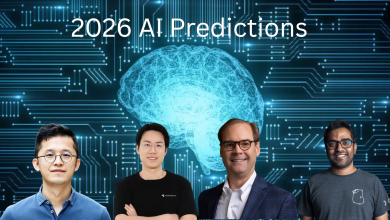
The idea that AI will steal our jobs is a common fear, especially for those who are just beginning to encounter the technology in their everyday lives. However, the future of AI in the workforce is less about the wholesale replacement of human jobs and more about the potential for innovation and augmentation of our existing capabilities.
The focus of AI development for many companies today is not centered around replacing humans. Instead, it is the vision is one where AI is alongside us, enhancing our capabilities, and opening new doors of opportunity.
AI will not steal jobs, it will transform them
According to the World Economic Forum predictions report, more than 75% of companies are expected to adopt technologies such as big data, cloud computing, and AI. Furthermore, an impressive 86% of organisations will bring digital platforms and apps into their operations in the next five years. E-commerce and digital trade are also on the rise, with 75% of businesses jumping on board, and 81% are looking to integrate education and workforce tech by 2027. AI is already unarguably changing the ways in which we do business, and this trend shows no signs of slowing down.
In this evolving environment, AI is expected to create more jobs than it replaces. This is because AI will automate monotonous tasks, creating more time for employees to manage more strategic, creative, and complex responsibilities. For instance, in the finance industry, AI is the foundation of any meaningful fraud detection, while financial analysts focus on strategic insights and client relationships.
Preparing for the AI workforce: strategies for success
So, how do we gear up for this AI-driven future?
Continuous training and education are fundamental. We need to be ready to work with AI, not against it – which involves not only technical know-how but also the ability to collaborate and adapt to new technologies.
Governments and educational institutions have a crucial role to play in this transition by updating curricula to include AI-related skills and promoting lifelong learning initiatives – but the modern business is also hugely responsible for investing in reskilling and upskilling programs to help employees perform. In fact, it is expected that 66% of businesses will see a positive return on investment within just one year of implementing these programs.
We should also note that, for many businesses, the AI technologies they use is no different to the brains inside a ChatGPT; they are using the same Natural Language Processing (NLP) that a conventional Generative AI would. That means that the workforce can get to grips with the basic principles of AI through their own personal use of the technology, and then apply those lessons to the workplace.
This commitment to continuous learning will ensure that the workforce remains agile and prepared for the changes brought about by AI.
Collaboration between humans and AI
Instead of viewing AI as a competitor, organisations should foster a culture where AI is seen as a valuable tool that enhances human capabilities.
For example, in the creative industries, AI can be used to generate ideas or streamline production processes, allowing artists and designers to focus on the conceptual and creative aspects of their work. In advertising, AI tools can analyse consumer data to generate valuable insights, while marketers craft creative campaigns based on that information.
With that said, AI is not a substitute for human creativity. While it can be taught to emulate what you might call ‘applied creativity’ – the generation of ideas within a specific set of rules and frameworks – but it cannot pull inspiration from thin air. AI still needs people to guide and refine its outputs, transforming raw data into meaningful and impactful creative work.
With that in mind, emphasising the collaborative powers of AI will help alleviate fears of replacement, and ultimately promote a more harmonious integration of the technology into the workforce. By highlighting the ways in which AI can augment human skills and creativity, companies can create an environment where employees feel empowered rather than threatened by new AI technologies.
Social and ethical considerations
Of course, social considerations are equally important in the discussion of AI’s future in the workforce. Policymakers need to address the potential disparities that AI adoption might cause, particularly in terms of job displacement in certain demographics or regions, depending on how new AI breakthroughs are achieved. Major technological developments, from the internet to the grain mill, have historically triggered some sort of social backlash. This makes it even more important to address ethical considerations around AI deployment, such as data privacy and algorithmic bias, to build and maintain public trust in these technologies.
Ensuring that AI is developed and deployed ethically is critical in gaining public trust and acceptance. This involves creating transparent and fair algorithms, protecting user data, and addressing any biases that may arise in AI systems. This has already begun on a governmental level: in the European Union (EU) with the recent establishment of the EU AI Office to implement and enforce the EU AI Act – the first-ever comprehensive legal framework on AI worldwide, which guarantees the health, safety and fundamental rights of people in the face of AI risks.
When leaders prioritise ethical considerations, both companies and governments can work together to foster a more inclusive and equitable AI-driven future.
Embracing the AI future
The advent of AI in the workforce does not signal the start of a bleak era in which people struggle with unemployment. It is about transforming how we work, enhancing human capabilities, and opening up new opportunities. By focusing on continuous learning, and collaboration, we can embrace AI as a powerful tool that leads to a more innovative, efficient, and empathetic workforce.
So: let’s look forward to a future where humans and AI thrive together, where AI empowers us to reach new heights, and where the workforce is more dynamic, adaptable, and resilient than ever before.




